Kyushu University
Kyushu University (九州大学, Kyūshū Daigaku), abbreviated to Kyudai (九大, Kyūdai), is a Japanese national university located in Fukuoka, in the island of Kyushu. It was the 4th Imperial Universities in Japan, ranked as 4th in 2020 Times Higher Education Japan University Rankings,[1] and selected as a Top Type university of Top Global University Project by the Japanese government. Kyudai is considered as one of the most prestigious research-oriented universities in Japan and is a member of the Alliance of Asian Liberal Arts Universities along with the University of Tokyo, Waseda University, Peking University and others.
九州大学 | |
 | |
Former names | Kyushu Imperial University |
|---|---|
Motto in English | Opening the Door to a New Century of Knowledge |
| Type | Public (National) |
| Established | Founded 1903, Chartered 1911 |
| Affiliation | Alliance of Asian Liberal Arts Universities |
| Endowment | $72 Million |
| Budget | $1.445 Billion |
| President | Chiharu Kubo |
Academic staff | 2,315 |
Administrative staff | 2,769 |
| Students | 18,925 |
| Undergraduates | 11,793 |
| Postgraduates | 7,132 |
| Location | Fukuoka , , Japan |
| Campus | Urban, (2.4 km²) Ito, urban, (0.4 km²) Hakozaki, urban, (0.3 km²) Maidashi, urban, (0.25 km²) Chikushi, urban, (0.063km²) Ohashi, rural, (0.1 km²) Beppu, Research Forests and Farms (72 km²) |
| Language | Japanese and English |
| Colours | Wine Red |
| Mascot | None |
| Website | www |


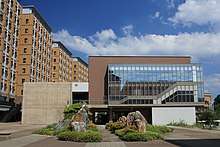
The history of Kyushu University can be traced back to the medical schools of the Fukuoka Domain (福岡藩 Fukuoka han) established in 1867. The school was reorganized to Fukuoka Medical College of Kyoto Imperial University in 1903 and became independent as Kyushu Imperial University in 1911. Albert Einstein visited the university on December 25, 1922.[2]
There are 2,089 foreign students (As of 2016) enrolled in the University. It was chosen for the Global 30 university program, and has been selected to the top 13 global university project.[3]
Symbol
Kyushu University does not have an official school song, instead it has one cheering song and three student songs including Matssubara-ni, with lyrics by Yoshifumi Akiyama.
The University's logo features a background of pine needles inset with an older iterance of the kanji for "university". The logo was officially established in 2004, but was originally proposed by a student, Sou Yoshihide, in the mid-20th century, and was used then on from 1950. There have also been alternatives designs, such as those featuring the Japanese KU or Q, for Kyushu instead of "university".
On March 3, prior to the incorporation of national universities in April 2004, the Committee of Public Relations agreed on a new university logo and color that symbolize Kyushu University under the new structure.
University logos
The pine needle design, which is used in the current university logo, remains in the new logo. On deciding the new logo, consideration was given as to whether it would still be highly distinctive even when electronically rendered. The introduction of the new logo, however, does not limit or eliminate the use of the previous one Fig. B.
Several patterns of university logos (Figs. C-F) have been created for use on PR materials and merchandise. Fig. C uses the same design as Fig. A without the two Chinese characters that mean “university,” while Fig. D illustrates a design using the capital letters of Kyushu University (KU). Fig. E symbolizes the letter “q” for “Q-shu” University. Fig. F is the logo originally printed on the university diploma. These logos are also registered and used as trademarks of Kyushu University.
Logo color
Dark red colors have been used for the logo of Kyushu University. The committee chose wine red as the new university logo color given that it is similar to the previous one and does not spoil the established image of Kyushu University's logo color. Since the visual effects of color can vary according to usage, a variation of the wine color within an allowable range can be used as the logo color. To allow broader variations, the use of sub-colors was also approved.
Global 30 Project
On July 3, 2009, Kyushu University was chosen as one of thirteen venues for the “Global 30 (G30) Project”, planned and funded by Japan's Ministry of Education, Culture, Sports, Science and Technology (MEXT). The major aim of the project is to further promote the globalization of Japanese higher education by assisting a select number of universities through the prioritized allocation of grants. The recipient schools are expected, among other things, to build and improve a system whereby overseas students may study and engage in research with minimal cultural and linguistic barriers. This more focused approach to budget allocation is also expected to help realize the government's public commitment to accommodate more than 300,000 international students on Japanese campuses by 2020.[4]
In February 2010, the University opened an all-purpose office in Cairo, Egypt, bringing the number of its overseas offices to 13 . Although the Cairo Office is managed by Kyushu University, all other Japanese colleges and universities can have access to its services and facilities when trying to recruit students or promote academic projects in Egypt.
By implementing these measures, Kyushu University is expecting to raise the number of its international students to 3,900 within a decade, a 300% increase over the current number. By the time the five-year grant terminates, the University will also have laid the foundation for a new interdisciplinary department (tentatively called the “International School of Arts and Sciences”), which is expected to launch by 2020.
Liberal arts subjects and basic sciences
For the first year and a half, students in the international undergraduate programs study various liberal arts subjects and basic sciences. This segment of the programs aims not only to equip students with in-depth liberal arts knowledge and to help them deepen their understanding of various disciplines, but also to broaden their range of interests, and to enable them to continue learning independently.
International Cooperation[4]
MJIIT (Malaysia-Japan International Institute of Technology)
The governments of Japan and Malaysia have jointly established a university in Malaysia which follows the Japanese style of education in engineering. It opened in September 2011. From the time the concept of this project was initiated, Kyushu University has played a core role and now, as the leading university of mechanical precision engineering subcommittee of a school specializing in precision mechanical engineering, it hopes to take an active role in the promotion of this project.
AUN/SEED-NET
(ASEAN University Network/ Southeast Asia Engineering Education Development Network) The AUN/SEED-Net was established in 2003 to full the following; to strengthen the main ASEAN universities education and research abilities, to strengthen the network between the universities of all the countries involved, including Japan, as well as, continuing to produce scientists needed in the economic and social areas of ASEAN nations. By accepting International Students and dispatching teachers, Kyushu University endeavors to train teachers of universities in ASEAN nations.
BOP by ICT
Income generation project for farmers at the BOP by ICT Kyushu University uses the funding from JICA to support Bangladeshi farming villages by creating business centers where ICT is used to provide farmers with the necessary information for farming. These centers are available anytime the farmer would like to visit. They are information hubs, where useful information regarding farmers produce and sales are being distributed by the use of ICT, amongst farmers in the hope that this will improve their income and reduce poverty.
University libraries

- Central Library (Hakozaki Campus)
- Medical Library (Medical Campus)
- Design Library (Ohashi Campus)
- Chikushi Library (Chikushi Campus)
- Ito Library (Ito Campus)
- Humanities and Social Sciences Library (Hakozaki Campus)
- Manuscript Library (Hakozaki Campus)
Number of holdings
(As of 1 April 2011)
| CJK | Western | Total | |
|---|---|---|---|
| Books (Volumes) | 2,283,821 | 1,773,967 | 4,057,788 |
| Serials (Titles) | 53,536 | 40,385 | 93,921 |
Undergraduate schools
- School of Interdisciplinary Science & Innovation
- School of Letters
- School of Education
- School of Law
- School of Economics
- School of Sciences
- School of Medicine
- School of Dentistry
- School of Pharmaceutical Sciences
- School of Engineering
- School of Design
- School of Agriculture
- The 21st Century Program
Graduate schools and faculties
Kyushu University has instituted a Graduate School/Graduate Faculty system - the first attempt of this kind at a Japanese university - as part of the overall reorganization of undergraduate and graduate education at the university in 2000. In separating the former Graduate School into the Graduate School (the education body) and the Graduate Faculty (the research body to which faculty members belong), the University is seeking to revitalize relationships between the Graduate Faculty and the Graduate School, and the Graduate Faculty and Undergraduate School. These changes should promote a more dynamic functioning of the Graduate Faculty in its relation to the Graduate School and the Undergraduate School. (Refer to chart below.)[4]
Under the Graduate School/Faculty system, all faculty members have been transferred from members of the Undergraduate Faculty to members of the Graduate Faculty. In addition, the educational body (Graduate School) and research body (Graduate Faculty) have become independent administrative entities. This new, more responsive administrative mechanism will enable Graduate Faculty members to participate more flexibly in the education of both the Undergraduate and Graduate School bodies. In implementing a more dynamic configuration of the education bodies (Undergraduate and Graduate Schools) and research body (Graduate Faculty), the university can more readily accommodate changes and shifts to pedagogic and research foci that may occur in the future.
| Graduate Schools | Graduate Faculties |
|
|
Kyushu University Hospital
| Director | Tatsuro Ishibashi MD, PhD | |
|---|---|---|
| Associate Directors | Seiji Nakamura DDS, PhD
Hiroshi Honda MD, PhD Yoichi Nakanishi MD, PhD Sumio Hoka MD, PhD Koshi Mimori MD, PhD Masami Hamada ND, Director of Nursing | |
| Address | [ Fukuoka ]
3-1-1 Maidashi, Higashi-ku Fukuoka 812-8582, JAPAN TEL :+81-(0)92-641-1151 (Mon-Fri 8:30 am – 5:00 pm) +81-(0)92-642-5163 (in after-hours) |
[ Beppu ]
4546 Tsurumibaru, Tsurumi, Beppu Ōita 874-0838, JAPAN TEL :+81-(0)977-27-1600 |
| Area | Site area: 311,239 m2
Floor area: 199,392 m2 |
Site area: 100,217 m2
Floor area: 18,291 m2 |
| Number of beds | 1,400 | 140 |
| Number of clinical departments
※ |
Medical departments: 36
Dental departments: 12 |
Medical departments: 5 |
| Number of patients
※ |
Inpatients:409,780 / year (1,123/ day)
Outpatients:690,822 / year (2,831 / day) |
Inpatients:33,899 / year (94 / day)
Outpatients:27,808 / year (114 / day) |
History
Kyushu University is one of the seven former Imperial Universities created in the Meiji period. The university is the largest research university in the Kyushu region with research centers in eleven different academic faculties, including the humanities, social sciences, medicine, and science.
Kyushu University Hospital is affiliated with the Faculty of Medical Sciences and the Faculty of Dental Science.
- 1867: The Kuroda Clan establishes an institution for Western medicine (Sanseikan) for the children of the lord and their retainers. The roots of present-day Kyushu University Hospital can be traced back to the clinic affiliated with that school.
- 1879: At the beginning of the Meiji period the clinic becomes an affiliated hospital of Fukuoka Prefectural Medical School.
- 1903: Fukuoka Medical College, a branch school of Kyoto Imperial University is established, and the hospital becomes affiliated with that school.
- 1911: Kyushu Imperial University is established in Fukuoka, and this hospital becomes affiliated with the university's Faculty of Medicine.
- 1931: The Research Institute of Balneotherapeutics is established in Beppu, Ōita Prefecture.
- 1945: Surviving crewmen from a downed American B-29 were subjected to medical experiments and vivisection conducted by members of the university's medical faculty.[7]
- 1947: Following the university reform that took place after World War II, the hospital's name was changed to the Kyushu University Faculty of Medical Sciences Affiliated Hospital. Fifteen departments, including a dental department, were established.
- 1967: The Faculty of Dental Science becomes an independent facility. The Faculty of Dental Science Affiliated Hospital opens.
- 2003: The three hospitals affiliated with Faculty of Medical Sciences, Faculty of Dental Science and Medical Institute of Bioregulation merge to form Kyushu University Hospital.
- 2009: Plans for the construction of a new hospital, which began in 2000, are completed. The new hospital consists of a South Ward, North Ward, West Ward and Outpatient Ward.
Research institutes
Medical Institute of Bio-regulation
The Medical Institute of Bioregulation at Kyushu University seeks to facilitate understanding of the essential regulatory mechanisms involved in human biology at the cellular and molecular levels, with a long-term goal of curing diseases.[4]
Research Institute for Applied Mechanics
The Research Institute for Applied Mechanics (RIAM) was established in, and consists of three research divisions (the Division of Renewable Energy Dynamics, the Division of Earth Environment Dynamics, and the Division of Nuclear Fusion Dynamics) as well as the two research centers of the Center for East Asian Ocean-Atmosphere Dynamics (COAR) and the Advanced Fusion Research Center (AFRC). In 1997, RIAM was recognized as an inter-university collaboration research institute and became a Center of Excellence (COE), nationally promoted by the Ministry of Education, Culture, Sports, Science and Technology (MEXT). In 0 0, RIAM was again admitted to the COE of applied mechanics for the period between 0 0 and 0 by MEXT.
Institute for Materials Chemistry and Engineering
The IMCE consists of four divisions engaged in a wide variety of research, including the synthesis of new functional molecules, the chemistry of new molecular assemblies, the chemistry of organic-inorganic hybrid materials, and the processing of advanced materials into devices. In cooperation with research groups in each field, the IMCE promotes research related to the basic science and application of the structure and functions of materials ranging from the atomic, molecular and nanoscale to macroscales. The IMCE is spread across three campuses in Chikushi, Hakozaki and Ito. The faculty members on each campus respectively belong to the Interdisciplinary Graduate School of Engineering Sciences, the Graduate School of Sciences, and the Graduate School of Engineering, as well as the Graduate School of Integrated Frontier Sciences. Their work includes recruiting graduate students for masters and doctoral courses in their respective graduate schools.
Institute of Mathematics for Industry[8]
Mathematics for Industry (MI) is a new research area that will provide a foundation for creating future technologies. It has been created with the aim of responding to the needs of the industrial sector by reorganizing and merging pure and applied mathematics into flexible and versatile forms. The Institute of Mathematics for Industry (IMI), established in April 2011, is the first research organization for mathematics in Asia involved with industrial technologies. It is constituted by the divisions of "Advanced Mathematics Technology", "Applied Mathematics" and "Fundamental Mathematics". Also included is the Office for Promotion of Collaboration and Consultation to promote smooth interaction and joint research with industry.
Institute of Health Science
The Institute of Health Science was established in 1978 as a comprehensive research and educational institute to tackle fundamental issues of health science, and to promote and maintain human health by using innovative and unique research.
Information Infrastructure Initiative
The Information Infrastructure Initiative is an organization that provides information infrastructures for both inside and outside of Kyushu University. For inside the university, the Information Infrastructure Initiative provides services such as Educational Computer Environments, Campus-Wide Software, Authentication and Authorization, Teleconferencing, University Mail, Hosting Services, Shared Storage, Networks, and Information Security. For outside the university, the Information Infrastructure Initiative provides high performance computing resources and academic databases for university researchers all over Japan. The Information Infrastructure Initiative is composed of the Research Division, the Technical Support Division, and the Administration Division. The Research Division has six sections: The Academic Information Section, Language Education Environment Section, Learning Spaces Design Section, Next Generation and Future Network Section, Interdisciplinary Computational Science Section and Advanced Computing Infrastructure Section.
Research Institute for East Asia Environments (RIEAE)[9]
The East Asian Environmental Problems Project, overseen by Kyushu University, was initiated in September 2007 as one of the events conducted to mark the 100th anniversary of the university. The project was reestablished as the Research Institute for East Asia Environments (RIEAE) in April 2009. RIEAE proposes what our nation must do as a member of the community of East Asian countries to find and provide practical solutions to environmental problems that require international cooperation with industry, government, and academia.
The mission of RIEAE is to provide practical solutions to environmental problems, which are growing in severity in the East Asian region. RIEAE was established as a leading institute that seeks to quickly respond to the diverse and pressing environmental issues of the East Asian region, and to contribute to the development of the East Asian region through international cooperation with industry, government, and academia. Presided over by the president of Kyushu University, RIEAE is one of the university's largest specific research projects.
Institutes for the Joint Use of Kyushu University[4]
- Biotron Application Center
- Institute of Tropical Agriculture
- Radioisotope Center
- Center for Advanced Instrumental Analysis
- The International Student Center
- The Kyushu University Museum
- System LSI Research Center
- Space Environment Research Center (SERC)
- Research Center for Korean Studies
- Research Center for Education in Health Care System
- Research Institute of Superconductor Science and Systems
- Integrated Kansei Design Center
- Art, Science, and Technology Center for Cooperative Research
- Research Laboratory for High Voltage Electron Microscopy
- Center of Environment and Safety
- Natural Disaster Information Center of Western Japan
- Laboratory for Ionized Gas and Laser Research
- Kyushu University Archives
- Robert T. Huang Entrepreneurship Center (QREC)
- Admission Center
- International Research Center for Hydrogen Energy
- Center for Future Chemistry
- Bio-Architecture Center
- Research Center for Steel
- Low Temperature Center
- Center for Accelerator and Beam Applied Science
- Inamori Frontier Research Center
- Research and Education Center of Carbon Resources
- Research Center for Synchrotron Light Applications
- Incubation Center for Advanced Medical Science (ICAMS)
- ITOH Research Center for Plasma Turbulence
- Material Management Center
- International Research Center for Molecular Systems (IRCMS)
- Center for Japan-Egypt Cooperation in Science and Technology (E-JUST Center)
- Center for Applied Perceptual Research
- Center for Plasma Nano-Interference Engineering
- Center for Advanced Medical Innovation
- EU Center (EUIJ-Kyushu)
- Research Center for Advanced Immunology
- Research Center for Environmental and Developmental Medical Sciences
- Research Center for Cancer Stem Cell
- Risk Science Research Center
- Research Center for Nucleotide Pool
- Epigenome Network Research Center
- Center for Asian Conservation Ecology
- Human Proteome Research Center
- Center for Advanced Research in Drug Creation (CARDC)
- Yunus and Shiiki Social Business Research Center (SBRC)
- Research Center for Advanced Biomechanics
TOPICS-Distinctive Research and Education[4]
LL.M. Program in International Economic & Business Law
Taught from a Japanese perspective, the one-year program offers students the opportunity to study international economic and business law, and Japanese and comparative law in a Japanese law faculty. A three-year LL.D. program and another one-year Master's course in Comparative Studies of Politics and Administration in Asia (CSPA) were launched in October 1999. As a result of the success of these programs, in 2001, Kyushu University was invited by the Ministry of Education to host the Young Leader's Program in Law, a program which, among others, seeks to foster good relations among future national leaders in Asia and other countries. In 2009, it was again selected by the Ministry of Education to host a Bilingual Program in law (LL.M). This unique master aims to overcome barriers of language and culture in the field of international law. This is achieved through law classes conducted in both Japanese and English, an internship, as well as a thesis written in both languages. Its first batch of students graduated in 2010.
Exploratry Research for Advanced Technology (ERATO)[10]
The Exploratory Research for Advanced Technology (ERATO) research funding program was founded in 1981, to promote basic research in science and technology. Its mission was to make Japan a world leader in science and technology: bringing a brighter future for Japan as well as making significant contributions to the international community.
In 2002, influenced by the government's “Second-stage Basic Plan (Master Plan) for Science and Technology” (2001-2006) and by the strategies set_up by the Council for Science and Technology Policy (CSTP), ERATO received a complete makeover, under the bigger umbrella of “Strategic Basic Research Programs” initiated by the government.
The goal of Strategic Basic Research Programs is to promote problem-solving oriented basic research, guided by strategies set by the government based on social and economic needs as well as the national policy on science and technology.
International Institute for Carbon-Neutral Energy Research (I²CNER)[11]
Director: Prof. Petros Sofronis
The International Institute for Carbon-Neutral Energy Research (I2CNER) was established on the Ito Campus in December, 2010. I2CNER is the newest of six research institutes to be funded under the World Premier International Research Center Initiative (WPI) program sponsored by the Ministry of Education, Culture, Sports, Science and Technology (MEXT). The objective of the I2CNER is to realize a carbon-neutral energy fueled society through Green Innovation.
Center for Organic Photonics and Electronics Research[12]
Director: Prof. Chihaya Adachi
The new research building for the Center for Organic Photonics and Electronics Research (OPERA) was completed at the ITO campus in August 2011 and several OPERA research laboratories have been constructed inside. The building has three doors and is 2400 square meters in area, and has a clean room, physical equipment room, synthetic laboratory rooms, conference rooms and a cafe.
JST ERATO Takahara Soft Interfaces Project
The 19th century was the era of hard materials such as steel, some of which were replaced by polymers in the 20th century. The 21st century will be the time of “soft materials”, including polymers, colloids, gels, vesicles, emulsions, films, surfactants, micelles, suspensions and liquid crystals. They are essential to produce various electrical & optical devices, and biodevices etc. The soft materials are increasingly indispensable in our daily lives. Since surfaces and interfaces of soft materials“( soft interfaces”) play an important role in various technological applications and bio-interfaces, precise control of soft interfaces would greatly promote the innovation of future science and technology. In this project, we are focusing on the understanding of fundamental science of soft interfaces formed in nature and extract the molecular and structure design principles. The following three groups are organized in order to pursue this project: 1) Precise molecular design of soft interfaces based on precise synthetic chemistry, 2) Hierarchical structural control and fabrication of soft interfaces through understanding natural systems, and 3) Development of in situ and dynamical characterization methods of soft interfaces.
Academic rankings
| Toyo Keizai National[13] | General | 8 |
|---|---|---|
| Kawaijuku National[14] | General | 7 |
| T. Reuters National[15] | Research | 6 |
| WE National[16] | Employment | 53 |
| NBP Kyushu/Okinawa/Yamaguchi[17] | Reputation | 1 |
| Shimano National[18] | Selectivity | SA |
| QS Asia (Asian Ranking version)[19] | General | 18 |
| ARWU Asia[20] | Research | 19-26 |
| THE World[21] | General | 401-500 |
| QS World[22] | General | 126 |
| ARWU World[20] | Research | 151-200 |
| ENSMP World[23] | Alumni | 38 |
| Social Sciences & Humanities | ||
|---|---|---|
| LAW | ||
| BE Success National[24] | Qualification | 15 |
| BE Pass rate National[25] | Qualification | 17 |
| BUSINESS & MANAGEMENT | ||
| Eduni MBA National[26] | General | 18 |
| Eduni MBA World[27] | General | 616 |
| Natural Sciences & Technology | ||
| Engineering | ||
| MATERIALS SCIENCE | ||
| T.Reuters National[28] | Research | 6 |
| T.Reuters World[28] | Research | 49 |
| CHEMISTRY | ||
| T.Reuters National[28] | Research | 6 |
| T.Reuters World[28] | Research | 41 |
| BIOLOGY & BIOCHEMISTRY | ||
| T.Reuters National[28] | Research | 4 |
| T.Reuters World[28] | Research | 95 |
| Life Sciences | ||
| IMMUNOLOGY | ||
| T.Reuters National[28] | Research | 4 |
| T.Reuters World[28] | Research | 68 |
| PHARMACOLOGY & TOXICOLOGY | ||
| T.Reuters National[28] | Research | 4 |
| T.Reuters World[28] | Research | 76 |
| * T. Reuters World rankings include non-educational institutions | ||
General rankings
The university has been ranked 5th in the 2020 Times Higher Education Japan University Rankings,[1] which is one rank down from 2019.[29] In another ranking, Japanese prep school Kawaijuku ranked Kyushu as the 7th best university in Japan.[14]
It has been ranked 132nd in the 2020 QS World University Rankings,[30] and 401-500th in the Times Higher Education World University Rankings.[31]
According to QS, its subject rankings were: 123rd in Engineering & IT, 170th in Life Sciences & Biomedicine, and 150th in Natural Sciences. It is also the 18th best university in Asia, according to QS Asian University rankings.[32]
Research performance
Kyushu is one of the top research institutions in Japan. According to Thomson Reuters, Kyushu is the 6th best research university in Japan.[15] Its research excellence is especially distinctive in Materials Science (6th in Japan, 49th in the world), Chemistry (6th in Japan, 41st in the world), Biology & Biochemistry (4th in Japan, 95th in the world), Immunology (4th in Japan, 68th in the world), and Pharmacology & Toxicology (4th in Japan, 76th in the world).[33]
Weekly Diamond reported that Kyushu has the 16th highest research standard in Japan in terms of research funding per researchers in COE Program.[34] In the same article, it is also ranked fifth in terms of the quality of education by GP funds per student.
Furthermore, Nikkei Shimbun on 2004/2/16 surveyed about the research standards in Engineering studies based on Thomson Reuters, Grants in Aid for Scientific Research and questionnaires to heads of 93 leading Japanese Research Centers, and Kyushu was placed 11th (research planning ability 10th) in this ranking.[35]
Kyushu University is one of Japan's National Seven Universities. Since Prof. Suzuki received the Nobel Prize in 2010, all the other Universities have alumni or professors who received a Nobel Prize. Kyushu University is the only National Seven University whose alumni or staff have not won a Nobel Prize.
Graduate school rankings
Eduniversal ranked Kyushu as 9th in the rankings of "Excellent Business Schools nationally strong and/or with continental links " in Japan.[36]
Kyushu was ranked 12th in the number of successful candidates of the Japanese Bar Examination in 2009 and 15th in 2010 in Japan.[37]
Alumni rankings
According to the Weekly Economist's 2010 rankings, graduates from Kyushu have the 53rd best employment rate in 400 major companies in Japan.[38]
École des Mines de Paris ranks Kyushu University as 38th in the world in 2011 in terms of the number of alumni listed among CEOs in the 500 largest worldwide companies.[23]
Popularity and selectivity
Kyushu is one of the most selective universities in Japan. Its entrance difficulty is usually considered as one of the top in Japan.[39][40]
Scholarships for international students
Kyushu offers a number of selected scholarships for international students. Some of them are:[41]
- Topia Leisure Scholarship (scholarship with work experience)
- JASSO - Encourage privately financed international students learning costs
- Fukuoka International Student Scholarship
- Ushio Foundation Scholarship
- Ajinomoto Scholarship
- Sun Noh Scholarship
Notable people associated with Kyushu University
| Wikimedia Commons has media related to Representation of Imperial University (Japan). |
Chemistry, Physics and Engineering
 Koichi Wakata (若田 光一) Ph.D., cosmonaut, the first Japanese commander of the International Space Station.
Koichi Wakata (若田 光一) Ph.D., cosmonaut, the first Japanese commander of the International Space Station.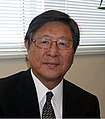 Toyoki Kunitake (國武 豐喜), chemist and materials scientist, 2015 Kyoto Prize winner.
Toyoki Kunitake (國武 豐喜), chemist and materials scientist, 2015 Kyoto Prize winner. Seiji Shinkai (新海 征治), pioneer in molecular self-assembly, but missed out on the 2016 Nobel Prize in Chemistry.
Seiji Shinkai (新海 征治), pioneer in molecular self-assembly, but missed out on the 2016 Nobel Prize in Chemistry.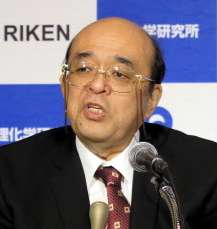 Kōsuke Morita (森田 浩介), experimental nuclear physicist, known as the leader of the Japanese team that discovered element 113.
Kōsuke Morita (森田 浩介), experimental nuclear physicist, known as the leader of the Japanese team that discovered element 113.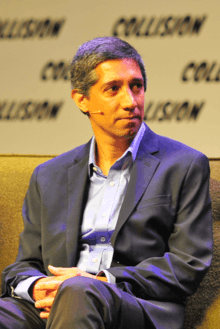
- Kyozi Kawasaki (川崎 恭治), physicist, 2001 Boltzmann Medal winner.
- Genichi Taguchi (田口 玄一), engineer and statistician.
- Heitaro Nakajima, (中島 平太郎), digital audio pioneer, president Aiwa
Physiology or Medicine
 Ryukichi Inada (稲田 龍吉), physician, 1919 Nobel Prize in Physiology or Medicine nominee.
Ryukichi Inada (稲田 龍吉), physician, 1919 Nobel Prize in Physiology or Medicine nominee. Fujiro Katsurada (桂田 富士郎), a parasitologist who discovered a parasite called Schistosoma japonicum.
Fujiro Katsurada (桂田 富士郎), a parasitologist who discovered a parasite called Schistosoma japonicum. Sunao Tawara (田原 淳), a pathologist who discovered the atrioventricular node (Node of Tawara)
Sunao Tawara (田原 淳), a pathologist who discovered the atrioventricular node (Node of Tawara)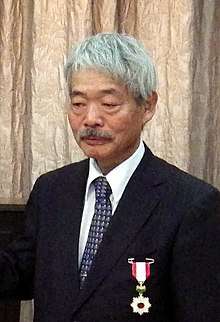 Tetsu Nakamura (中村 哲), physician, headed Peace Japan Medical Services (PMS), 2003 Ramon Magsaysay Award winner.
Tetsu Nakamura (中村 哲), physician, headed Peace Japan Medical Services (PMS), 2003 Ramon Magsaysay Award winner.
- Inokichi Kubo (久保 猪之吉), pioneer of otorhinolaryngology.
- Ōmori Harutoyo (大森 治豊), surgeon and first president of the Fukuoka Medical College.
- Yutaka Ido (井戸 泰), surgeon, 1919 Nobel Prize in Physiology or Medicine nominee.
- Naosuke Onodera (小野寺 直助), surgeon, 1937 Nobel Prize in Physiology or Medicine nominee.
- Kazuo Yamafuji (山藤 一雄), scientist, 1964 Nobel Prize in Physiology or Medicine nominee.
- Hakaru Hashimoto (橋本 策), M.D., Ph.D., medical scientist, discoverer of Hashimoto's thyroiditis.
- Masatoshi Nei (根井 正利), a Japanese-born American evolutionary biologist, 2013 Kyoto Prize winner.
- Yoshizumi Ishino (石野 良純), molecular biologist, known for his discovering the DNA sequence of CRISPR.
- Takehiko Sasazuki (笹月 健彦) M.D.,Ph.D. emeritus professor, professor of Kyushu University Institute for Advanced Study (高等研究院)[42]
Literature and History
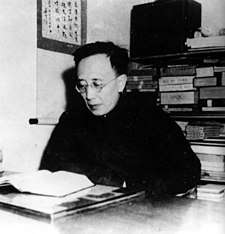 Guo Moruo (郭沫若), a Chinese archaeologist, historian, poet, politician, and writer.
Guo Moruo (郭沫若), a Chinese archaeologist, historian, poet, politician, and writer.- Yasushi Inoue (井上 靖), drop out, a Japanese writer, 1950 Akutagawa Prize winner and Nobel Prize in Literature nominee.[43]
- Junzo Shono (庄野 潤三), a Japanese novelist, 1954 Akutagawa Prize winner.
- Toshio Shimao (島尾 敏雄), a Japanese novelist, 1977 Yomiuri Prize winner.
- Kyoichi Katayama (片山 恭一), a Japanese author.
- Rizō Takeuchi (竹內 理三), historian
- Wolfgang Michel-Zaitsu, historian, first foreigner granted a tenure at a Japanese national university in 1984.
- Hsu Hsing-Ching (徐興慶), President of Chinese Culture University in Taiwan.
- Yasuhisa Hara (原 泰久), a Japanese cartoonist.
Politics and Business
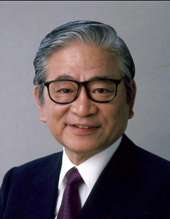 Shozaburo Jimi (自見 庄三郎) M.D., Ph.D., Minister of Posts and Telecommunications
Shozaburo Jimi (自見 庄三郎) M.D., Ph.D., Minister of Posts and Telecommunications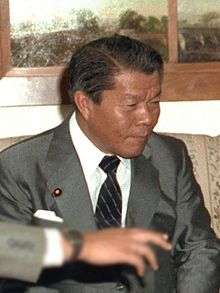
 Hsu Shih-hsien (許世賢), a Taiwanese academic and politician, the first Taiwanese woman to earn a doctorate.
Hsu Shih-hsien (許世賢), a Taiwanese academic and politician, the first Taiwanese woman to earn a doctorate. Tomihisa Taue (田上 富久), mayor of Nagasaki.
Tomihisa Taue (田上 富久), mayor of Nagasaki.
- Robert T. Huang, SYNNEX Corporation founder
See also
- National Seven Universities
- Campus of Kyushu University
- Kyushu Institute of Design
- Kyoto University
- Maidashi kyudai byoin mae
- IBM/Google Cloud Computing University Initiative
- Experimentation on American POWs
References
- . Times Higher Education (THE). 2020-05-30 https://www.timeshighereducation.com/rankings/japan-university/2020#!/page/0/length/25/sort_by/rank/sort_order/asc/cols/stats. Retrieved 2020-05-30. Missing or empty
|title=(help) - 九州大学物理学教室企画・主催 (2005-09-10). "世界物理年2005記念イベント 子どももおとなも楽しめるアインシュタインの宇宙". 九州大学物理学教室. Archived from the original on 2007-08-14. Retrieved 2012-05-01.
- "Selection for the FY 2014 Top Global University Project" (PDF). MEXT.
- http://www.isc.kyushu-u.ac.jp/intlweb/data/pdf/gaiyou.pdf
- "Kyushu University "Japan in Today's World" Program". www.isc.kyushu-u.ac.jp. Retrieved 2016-02-22.
- "ASEAN International Education Programme". www.isc.kyushu-u.ac.jp. Retrieved 2016-02-22.
- McCurry, Justin (2015-08-13). "Japan revisits its darkest moments where American POWs became human experiments". The Guardian. ISSN 0261-3077. Retrieved 2019-02-13.
- "九州大学 マス・フォア・インダストリ研究所". www.imi.kyushu-u.ac.jp. Retrieved 2016-02-22.
- "kyushu University Research Institute for East Asia Environments | Top". www.q-eaep.kyushu-u.ac.jp. Retrieved 2016-02-22.
- "ERATO". www.jst.go.jp. Retrieved 2016-02-22.
- "I2CNER". i2cner.kyushu-u.ac.jp. Retrieved 2016-02-22.
- "HOME - Funding Program for World-Leading Innovative R&D on Science and Technology". www.cstf.kyushu-u.ac.jp. Archived from the original on 2016-03-14. Retrieved 2016-02-22.
- "Truly Strong Universities" (in Japanese). Toyo Keizai. 2010. Retrieved April 29, 2011.
- "Kawai 30 Top Japanese Universities". Kawaijuku. 2001. Retrieved April 29, 2011.
- "Thomson Reuters 20 Top research institutions in Japan". Thomson Reuters. 2011. Retrieved April 29, 2011. (this raking includes 5 non-educational institutions)
- "Employment rate in 400 major companies rankings" (in Japanese). Weekly Economist. 2011. Retrieved April 29, 2011.
- "Nikkei BP Brand rankings of Japanese universities" (in Japanese). Nikkei Business Publications. 2010. Retrieved April 29, 2011.
- "GBUDU University Rankings" (in Japanese). YELL books. 2009. Retrieved April 29, 2011.
- "QS Asian University Rankings". QS Quacquarelli Symonds Limited. 2016. Retrieved September 24, 2017.
- "Academic Ranking of World Universities". Institute of Higher Education, Shanghai Jiao Tong University. 2017. Retrieved September 24, 2017.
- "THE World University Rankings". Times Higher Education. 2018. Retrieved September 24, 2017.
- "QS World University Rankings". QS Quacquarelli Symonds Limited. 2018. Retrieved September 24, 2017.
- "ENSMP World University Rankings" (PDF). École nationale supérieure des mines de Paris. 2011. Retrieved April 29, 2011.
- "Bar Exam Successful Applicants rankings" (in Japanese). Shikaku Seek. 2010. Retrieved May 11, 2011.
- "Bar Exam Pass rate rankings" (in Japanese). Shikaku Seek. 2010. Retrieved May 11, 2011.
- "Business School Ranking in Japan". Eduniversal. 2010. Retrieved May 11, 2011.
-
"University and business school ranking in 5 palms (Top100)". Eduniversal. 2010. Retrieved May 11, 2011.
"University and business school ranking in 4 palms (Top101-300)". Eduniversal. 2010. Retrieved May 11, 2011.
"University and business school ranking in 3 palms (Top301-696)". Eduniversal. 2010. Retrieved May 11, 2011.
"University and business school ranking in 2 palms (Top697-896)". Eduniversal. 2010. Retrieved May 11, 2011. - "Thomson Reuters 10 Top research institutions by subject in Japan" (in Japanese). Thomson Reuters. 2010. Retrieved May 11, 2011.
- . Times Higher Education (THE). 2020-05-30 https://www.timeshighereducation.com/rankings/japan-university/2019#!/page/0/length/25/name/kyushu%20university/sort_by/rank/sort_order/asc/cols/stats. Retrieved 2020-05-30. Missing or empty
|title=(help) - "QS World University Rankings 2020: Top Global Universities | Top Universities". Top Universities. 2020-03-18. Retrieved 2020-03-18.
- "World University Rankings". Times Higher Education (THE). 2017-08-18. Retrieved 2019-05-14.
- "QS University Rankings: Asia - 2011". Top Universities. 2012-12-19. Retrieved 2013-11-08.
- "Thomson Reuters 20 Top research institutions in Japan" (in Japanese). Thomson Reuters. Archived from the original on 2011-06-13. (this raking includes non-educational institutions)
- "週刊ダイヤモンド" ダイヤモンド社 2010/2/27 http://web.sapmed.ac.jp/kikaku/infomation/0227daiyamondokiji.pdf
- "大学工学部研究力調査(04.2.22)". Homepage3.nifty.com. Archived from the original on 2015-05-07. Retrieved 2013-11-08.
- "University and business school ranking in Japan". Eduniversal-ranking.com. Retrieved 2013-11-08.
- "2010年(平成22年)新司法試験法科大学院別合格率ランキング -法科大学院seek". Laws.shikakuseek.com. Retrieved 2013-11-08.
- "Employment rate in 400 major companies rankings" (in Japanese). Weekly Economist. 2011. Retrieved Apr 29, 2011.
- e.g. Yoyogi seminar published Hensachi (the indication showing the entrance difficulties by prep schools) rankings "Archived copy". Archived from the original on 2011-04-22. Retrieved 2016-07-29.CS1 maint: archived copy as title (link)
- Japanese journalist Kiyoshi Shimano ranks Kyushu's entrance difficulty as SA (most selective/out of 11 scales) in Japan. 危ない大学・消える大学 2012年版 (in Japanese). YELL books. 2011.
- Kyushu Scholarships for International Students
- 九州大学高等研究院・組織・メンバー Archived 2014-11-29 at the Wayback Machine (in Japanese)
- 安部公房は受賞寸前だった…ノーベル委員長語る YOMIURI ONLINE2012年3月23日
External links
| Wikimedia Commons has media related to Kyushu University. |
